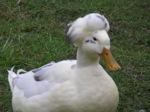Difference between revisions of "Coccidiosis - Duck"
| (10 intermediate revisions by 3 users not shown) | |||
| Line 1: | Line 1: | ||
| − | [[Image:Crested duck.jpg|thumb|right|150px | + | {{OpenPagesTop}} |
| − | + | == Introduction == | |
| + | [[Image:Crested duck.jpg|thumb|right|150px]] | ||
| + | Coccidiosis in ducks in not well researched or studied, but it is a common disease in both farmed and wild ducks and can cause significant morbidity and mortality when there is no resistance developed (therefore disease is more common in farmed ducks, whereas subclinical infections are predominant in wild ducks). | ||
| − | + | Currently 13 species of [[:Category:Coccidia|coccidia]] have been reported in ducks but only certain species have been researched. ''[[Eimeria spp.|Eimeria]], Wenyonella'' or ''Tyzzeria'' genuses are found in wild and farmed birds. | |
| − | + | There are several pathogenic strains with some ''Eimeria'' species producing caseous core lesions in the caecum as well as petechial haemorrhages and congestion. Other species are known to cause severe enteritis and pale focal lesions in the small intestine. Sloughing of the intestinal wall in long sheets may also be seen and the coccidia may invade very deep to the muscular layers of the intestinal wall. | |
| − | + | ||
| − | [[Category: | + | Ducklings, under 7 weeks of age are most severely affected by the disease, with high mortality seen in these birds. |
| + | |||
| + | |||
| + | == Clinical Signs == | ||
| + | |||
| + | Severe enteritis and haemorrhagic diarrhoea is seen with the most pathological strains of the disease along with mucoid discharge. Weight loss, reduced appetite and depression are other common signs. | ||
| + | |||
| + | |||
| + | == Diagnosis == | ||
| + | |||
| + | Clinical signs and history are usually enough to make a presumptive diagnosis. Post mortem examination should be performed on sick birds that are not likely to recover (these will be sacrificed for this purpose) and the lesions examined. Observation of caseous core lesions in the caecum and sloughing of the intestinal walls will strengthen a presumptive diagnosis, but samples should be taken for microscopic inspection to identify the coccidia. | ||
| + | |||
| + | |||
| + | == Treatment and Control == | ||
| + | |||
| + | Control is dependent on hygiene and good husbandry, such as disinfection of housing and good ventilation. | ||
| + | |||
| + | Treatment with sulphonamides only, in the case of an outbreak, as other anticoccidals may not be safe to use. | ||
| + | |||
| + | |||
| + | |||
| + | == References == | ||
| + | |||
| + | Merck & Co (2008) The Merck Veterinary Manual (Eighth Edition) Merial<br>Jordan, F, Pattison, M, Alexander, D, Faragher, T (1999) Poultry Diseases (Fifth edition) W.B. Saunders<br>Saif, Y.M (2008) Diseases of Poultry (Twelfth edition) Blackwell Publishing | ||
| + | |||
| + | |||
| + | |||
| + | {{review}} | ||
| + | |||
| + | {{OpenPages}} | ||
| + | |||
| + | [[Category:Alimentary_Diseases_-_Birds]] [[Category:Expert_Review - Bird]] | ||
Latest revision as of 14:21, 20 July 2012
Introduction
Coccidiosis in ducks in not well researched or studied, but it is a common disease in both farmed and wild ducks and can cause significant morbidity and mortality when there is no resistance developed (therefore disease is more common in farmed ducks, whereas subclinical infections are predominant in wild ducks).
Currently 13 species of coccidia have been reported in ducks but only certain species have been researched. Eimeria, Wenyonella or Tyzzeria genuses are found in wild and farmed birds.
There are several pathogenic strains with some Eimeria species producing caseous core lesions in the caecum as well as petechial haemorrhages and congestion. Other species are known to cause severe enteritis and pale focal lesions in the small intestine. Sloughing of the intestinal wall in long sheets may also be seen and the coccidia may invade very deep to the muscular layers of the intestinal wall.
Ducklings, under 7 weeks of age are most severely affected by the disease, with high mortality seen in these birds.
Clinical Signs
Severe enteritis and haemorrhagic diarrhoea is seen with the most pathological strains of the disease along with mucoid discharge. Weight loss, reduced appetite and depression are other common signs.
Diagnosis
Clinical signs and history are usually enough to make a presumptive diagnosis. Post mortem examination should be performed on sick birds that are not likely to recover (these will be sacrificed for this purpose) and the lesions examined. Observation of caseous core lesions in the caecum and sloughing of the intestinal walls will strengthen a presumptive diagnosis, but samples should be taken for microscopic inspection to identify the coccidia.
Treatment and Control
Control is dependent on hygiene and good husbandry, such as disinfection of housing and good ventilation.
Treatment with sulphonamides only, in the case of an outbreak, as other anticoccidals may not be safe to use.
References
Merck & Co (2008) The Merck Veterinary Manual (Eighth Edition) Merial
Jordan, F, Pattison, M, Alexander, D, Faragher, T (1999) Poultry Diseases (Fifth edition) W.B. Saunders
Saif, Y.M (2008) Diseases of Poultry (Twelfth edition) Blackwell Publishing
| This article has been peer reviewed but is awaiting expert review. If you would like to help with this, please see more information about expert reviewing. |
Error in widget FBRecommend: unable to write file /var/www/wikivet.net/extensions/Widgets/compiled_templates/wrt6939de87698014_98322188 Error in widget google+: unable to write file /var/www/wikivet.net/extensions/Widgets/compiled_templates/wrt6939de877ff2f0_81801902 Error in widget TwitterTweet: unable to write file /var/www/wikivet.net/extensions/Widgets/compiled_templates/wrt6939de87942969_39092737
|
| WikiVet® Introduction - Help WikiVet - Report a Problem |
